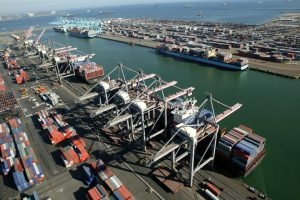
Hackett Associates in its latest Global Port Tracker report produced for the National Retail Federation (NRF) marks an “unusually high” growth in import volumes of US major retail container ports in January 2017, up 12.5% as compared with the previous year, reports NRF.
The ports covered by the Global Port Tracker include Los Angeles/Long Beach, Oakland, Seattle and Tacoma on the West Coast; New York/New Jersey, Hampton Roads, Charleston, Savannah, Port Everglades and Miami on the East Coast, and Houston on the Gulf Coast. All together they handled 1.67 mln TEU in the first month of 2017, which is 6.5% higher than in December 2016 and 12.5% than in January 2016.
The report forecasts February import volumes at 1.61 mln TEU, which will mean a 4.2% increase on a year-on-year basis. In March this parameter is expected at 1.46 mln TEU (+10.6%), in April at 1.59 mln TEU (+10.1%), in May at 1.67 mln TEU (+2.9%), in June at 1.66 mln TEU (+5.5%) and in July at 1.71 mln TEU (+5.2%).
Therefore, the first half of 2017 is expected to total 9.7 mln TEU, which will mean a 7.4% rise y-o-y. This will be more than four times the 1.6% growth seen in the first half of 2016.
For the full year 2016 import volumes at these major container ports grew by 3.1%, up to 18.8 mln TEU.
NRF sees a growing economy as the main driver for the double-digit growth in imports at major container ports in the United States in March and April, “despite tariff and border tax talk in Washington”.
Jonathan Gold, NRF Vice President for Supply Chain and Customs Policy, said in a statement: “Consumers are spending more freely and retailers are stocking up for the spring and summer seasons. Merchants are making sure they are prepared to meet growing demand, and imports are essential to providing American families with the products they need at prices they can afford.”
Ben Hackett, the founder of Hackett Associates, adds: “The threat of a ‘border adjustment’ tax, withdrawal from the Trans-Pacific Partnership and a possible rewrite of the North American Free Trade Agreement might eventually dampen the trading spirit and discourage international trade. In the meantime, the opposite is happening – trade is continuing to grow despite these developments in Washington.”
These figures come as the American Society of Civil Engineers’ (ASCE) released its 2017 Infrastructure Report Card, where graded US marine port infrastructure a C+. This shows a slight improvement as compared to four years ago, when the country’s infrastructure was given just a C grade. However, it demonstrates that America’s port-related infrastructure is still a long way from adequate.
